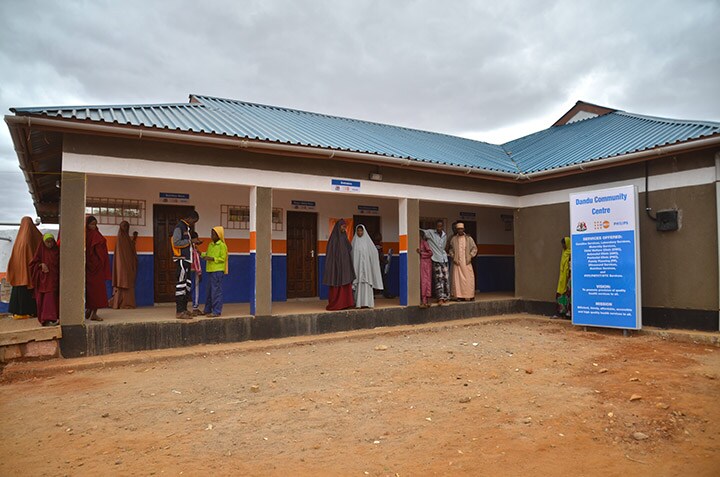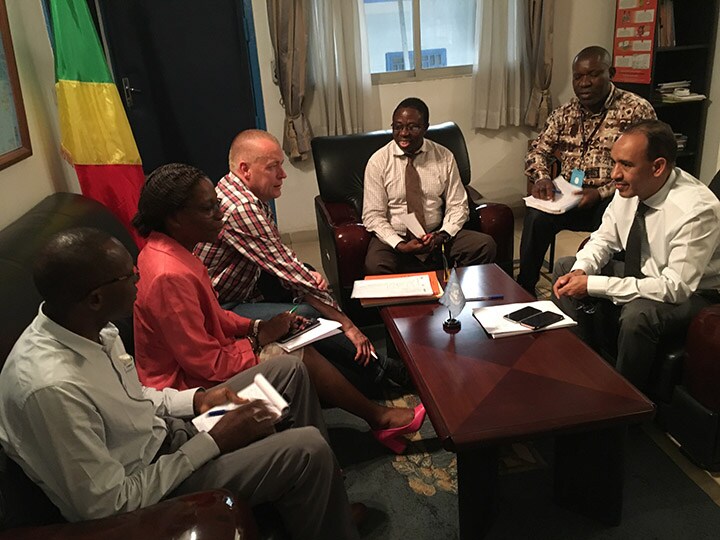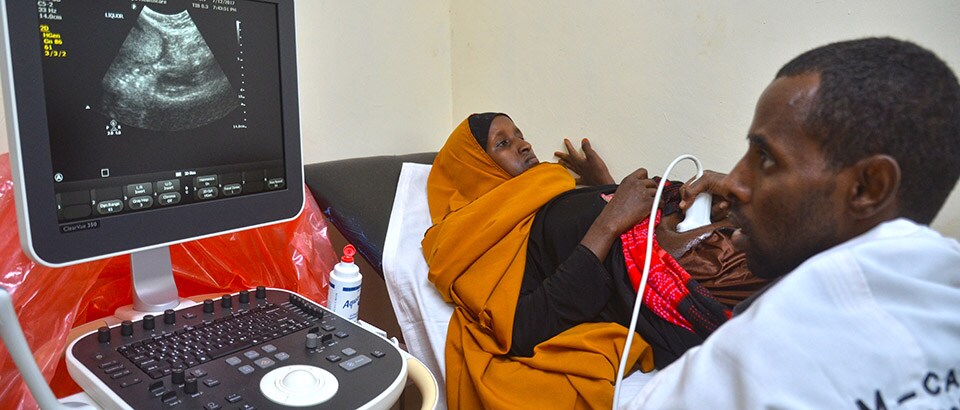Philips heeft een missie om de levens van 2,5 miljard mensen te verbeteren in 2030. En, wat daarbij vaak in één adem wordt genoemd; waaronder minimaal 400 miljoen mensen in achtergestelde gemeenschappen. Maar hoe? Iemand die al jarenlang bezig is om de toegang tot basisgezondheidszorg in arme landen te verbeteren, is Luc De Clerck. Als projectmanager van het zogeheten Community Life Centers-project bij Philips tuigt hij, samen met niet-gouvernementele organisaties (NGO’s), ziekenhuizen en overheden in Afrika en Azië, programma’s op de zorg in de meest afgelegen gebieden te verbeteren.
Special Forces
Daarvoor reist hij vanuit België de hele wereld over. “Dat is een gewoonte die niet helemaal nieuw is. Al vroeg na mijn studie fysiotherapie kwam ik terecht bij de Special Forces. Daar heb ik veel oorlogen en crisissen heb meegemaakt, van Centraal-Afrika tot Afghanistan.” Ook in een volgende fase van zijn carrière, in een brandwondencentrum van een militair ziekenhuis, reisde hij de wereld over: “We hebben ondersteuning geboden bij de nieuwjaarsbrand in Volendam, waar patiënten werden overgebracht naar België en Duitsland. Maar na 11 september 2001 zijn we ook in de VS ondersteuning gaan bieden in NAVO-verband.” Samen met andere ex-militairen richtte hij in 2003 een eigen NGO op: “FLAME richt zich op brandwondenzorg en crisiszorg. We begonnen met niks en zijn nog altijd actief, zelfs een referentiebrandwondencentrum.”
Noodzorg tijdens en na de bevalling
Al vrij snel na de start van zijn carrière bij Philips, in 2008, raakte hij betrokken bij een project in Afrika. “Toen ik op een evenement een presentatie gaf, over kwaliteitsverbetering van de patiëntenzorg in kritieke diensten van het ziekenhuis, kwam er iemand naar me toe die vertelde over een nieuw programma om in Zuid-Afrika noodzorg te bieden tijdens en na de bevalling, ook wel EmONC genoemd (emergency obstretic and newborn care).”

Dat idee kwam niet uit het niets: moeder- en kindersterfte is een enorm probleem in afgelegen gebieden. “We zijn een vrij unieke samenwerking aangegaan als bedrijf met universiteiten en overheden om meer en betere basiszorg te kunnen leveren in de buitengebieden. Niet in de steden, maar echt in wat we de ‘last mile’ noemen: in de meest afgelegen gebieden in tropische regenwouden.”
We zijn een vrij unieke samenwerking aangegaan als bedrijf met universiteiten en overheden om meer en betere basiszorg te kunnen leveren in de buitengebieden. Niet in de steden, maar echt in wat we de ‘last mile’ noemen: in de meest afgelegen gebieden in tropische regenwouden.
Luc De Clerck
Clinical Lead Connected Primary Health Solutions
“Je moet je voorstellen: als een vrouw in verwachting is, wil je eigenlijk dat ze 4 tot 8 prenatale onderzoeken krijgt. In de praktijk is het eerste bezoek vaak een uur voor de bevalling.” De aanpak: het oprichten van nieuwe gezondheidscentra in afgelegen gebieden. En bestaande centra helpen om betere kwaliteit zorg te kunnen leveren.
De drempel tot basiszorg zo laag mogelijk maken
“Er zijn daar drie niveaus van zorg: je hebt centrale ziekenhuizen, vaak in een stad. Daaronder vallen vaak meerdere, minder centraal gelegen districtsziekenhuizen. En de laag daaronder bestaat uit drie primaire gezondheidscentra. Wat wij onder meer doen, is ervoor zorgen dat de drempel tot basiszorg zo laag mogelijk is.” “Kan een zwangere vrouw niet naar een gezondheidscentrum komen? Dan komt een gezondheidswerker langs met een soort kliniek in een rugzak, de zogeheten Philips Outreach Kit. Deze hebben we mede ontwikkeld met de universiteit van Stellenbosch en er zit alles in wat ze nodig hebben voor een controle van moeder en kind: van met een draagbare bloeddrukmeter en pulse-oxymeter tot een draagbaar echografietoestel - de Philips Lumify.” “Het kwam ook nog weleens voor dat een vrouw wel naar een gezondheidscentrum kwam voor een bevalling, moest worden doorverwezen naar een districtsziekenhuis en dat ze daar in de problemen kwam omdat ze haar niet konden helpen. Er was geen systeem van doorverwijzen of kennisoverdracht, waardoor het sterftecijfers bij geboorte schrikbarend hoog was.”
Positieve impact op de gemeenschap
In het project Philips Community Life Centers werkt Philips samen onder meer samen met de United Nations Population Fund (UNFPA) om het hele zorgsysteem te verbeteren. “Hoe we dat doen, is echt uniek in de wereld. Het is niet zo dat Philips de leverancier is van het programma, we zijn egale partners. We leveren met zijn allen infrastructuur, energie, water, medische apparatuur en software en diensten. En iedereen zorgt voor zijn eigen financiering. Dat is een innovatief governance- en businessmodel wat in de praktijk zijn waarde al heeft bewezen; het heeft een enorme positieve impact op de gemeenschap.”

“Vroeger was er zo goed als geen gezondheidszorg voor moeder en kind, mensen stierven daardoor. Nu is er meer en meer toegang tot primaire zorg, wat niet alleen een verbetering oplevert van de kwaliteit van leven van de mensen in de dorpen, maar ook een ontlasting is voor de centrale ziekenhuizen, die daardoor betere zorg kunnen leveren aan andere patiënten.”
Nu is er meer en meer toegang tot primaire zorg, wat niet alleen een verbetering oplevert van de kwaliteit van leven van de mensen in de dorpen, maar ook een ontlasting is voor de centrale ziekenhuizen, die daardoor betere zorg kunnen leveren aan andere patiënten.
Luc De Clerck
Clinical Lead Connected Primary Health Solutions
Impact op levens van 240.000 vrouwen en 25.000 kinderen
Het programma heeft nu al impact op de levens van 240.000 vrouwen en 25.000 kinderen, maar Luc voorziet nog mogelijkheden om te groeien. “Wat we nu doen voor moeder en kind, kunnen we natuurlijk ook uitbreiden naar andere doelgroepen. Denk aan ouderenzorg in afgelegen gebieden, zorg op het gebied van diarree, malaria, ademhalingsproblemen; daar is ook nog een wereld te winnen.” Door het wereldwijde partnership met de UNFPA kan Philips nu overal ter wereld opschalen. “We zijn vorig jaar gestart met een project om het Congo-model ook in andere landen te gaan toepassen. Het doel: het sterftecijfer onder pasgeboren baby’s in afgelegen gebieden binnen vijf jaar met 50 procent terug te dringen.” Sinds 2020 krijgt het project ook steun van de Nederlandse Financierings-Maatschappij voor Ontwikkelingslanden om complexe programma’s op grote schaal op te zetten in Afrika. “We wisten vanaf het begin dat dit soort initiatieven een kwestie van lange adem zijn. Maar dat we de afgelopen jaren deze mooie stappen hebben kunnen zetten, ondanks de pandemie – die de uitvoering van projecten in de praktijk zwaar bemoeilijkte – dat biedt heel veel hoop voor de toekomst.” In de serie ‘duurzaam doen’ laten we de mensen aan het woord die zich binnen Philips elke dag bezighouden met het realiseren van duurzaamheidsdoelstellingen. "Al bij de eerste design-schets moet je nadenken over circulariteit." Samen met haar team is Design Strategist Aylin Groenewoud elke dag bezig om de producten en diensten van Philips nog groener te maken.
Lees ook:
Philips wil 2,5 miljard levens verbeteren in 2030; hoe en waarom meten we dat? Robert Metzke, Head of Sustainability, legt uit waarom Philips zichzelf duurzaamheidsdoelstellingen stelt en hoe de resultaten worden gemeten en berekend.
Teddy Heerbaart doet er binnen Philips Circular Equipment alles aan om goede onderdelen van medische apparatuur niet verloren te laten gaan, maar juist in te zetten voor de toekomst. “Bij ons krijgt medische apparatuur een tweede, en soms zelfs een derde leven.”

"Philips Community Life Centers are helping to solve a huge problem in remote areas: high maternal and child mortality"
Philips is on a mission to improve the lives of 2.5 billion people by 2030; including at least 400 million people in disadvantaged communities. But how? Someone who has been working for years to improve access to basic healthcare in poor countries is Luc De Clerck. As project manager of the so-called Community Life Centers project at Philips, he is setting up programs with non-governmental organizations (NGOs), hospitals and governments in Africa and Asia to improve care in the most remote areas.
Special Forces
To do this, he travels all over the world from Belgium. "That is a habit that is not entirely new. Early on after studying physical therapy, I ended up in the Special Forces. There I experienced many wars and crises, from Central Africa to Afghanistan." He also traveled the world in the next phase of his career, in a burn center of a military hospital: "We provided support for the New Year fire in Volendam, where patients were transferred to Belgium and Germany. But after September 11, 2001, we also started providing support in the U.S. in a NATO context." Together with other ex-military, he founded his own NGO in 2003: "FLAME focuses on burn care and crisis care. We started with nothing and are still active, even a reference burn center."
Emergency care during and after childbirth
Fairly soon after starting his career at Philips, in 2008, he became involved in a project in Africa. "When I was giving a presentation at an event, on quality improvement of patient care in hospital critical services, someone came up to me and told me about a new program to provide emergency care during and after childbirth in South Africa, also called EmONC (emergency obstretic and newborn care)."

That idea didn't come out of nowhere: maternal and child mortality is a huge problem in remote areas. "We entered into a pretty unique partnership as a company with universities and governments to provide more and better basic care in the outlying areas. Not in the cities, but really in what we call the 'last mile': in the most remote areas in tropical rainforests."
We have entered into a pretty unique partnership as a company with universities and governments to be able to deliver more and better basic care in the outlying areas. Not in the cities, but really in what we call the 'last mile': in the most remote areas in tropical rainforests.
Luc De Clerck
Clinical Lead Connected Primary Health Solutions
"You have to imagine: when a woman is expecting, you actually want her to have 4 to 8 prenatal examinations. In practice, the first visit is often an hour before delivery." The approach: establish new health centers in remote areas. And helping existing centers to provide better quality care.
Making the threshold to basic care as low as possible
"There are three levels of care there: you have central hospitals, often in a city. Below that are often several, less centrally located district hospitals. And the layer below that consists of three primary health centers. What we do, among other things, is make sure that the threshold to basic care is as low as possible."
"Can't a pregnant woman come to a health center? Then a health worker will come by with a kind of clinic in a backpack, called the Philips Outreach Kit. We co-developed this with the University of Stellenbosch and it contains everything they need for a check-up of mother and child: from with a portable blood pressure monitor and pulse oximeter to a portable ultrasound machine - the Philips Lumify."
"It also still sometimes happened that a woman did come to a health center for a delivery, had to be referred to a district hospital, and that she got into trouble there because they couldn't help her. There was no system of referral or knowledge transfer, so the mortality rate at birth was shockingly high."
Positive impact on the community
In the Philips Community Life Centers project, Philips is working with the United Nations Population Fund (UNFPA), among others, to improve the entire healthcare system. "How we do that is really unique in the world. It's not that Philips is the supplier of the program, we are equal partners. We all provide infrastructure, energy, water, medical equipment and software and services. And everyone provides their own funding. That's an innovative governance and business model which has already proven its value in practice; it has a huge positive impact on the community."

"Before, there was virtually no maternal and child health care, people died because of it. Now there is more and more access to primary care, which not only improves the quality of life of people in the villages, but also relieves the burden on the central hospitals, which can therefore provide better care to other patients."
Now there is more and more access to primary care, which not only improves the quality of life of the people in the villages, but also relieves the burden on the central hospitals, which can therefore deliver better care to other patients.
Luc De Clerck
Clinical Lead Connected Primary Health Solutions
Impact on lives of 240,000 women and 25,000 children
The program is already impacting the lives of 240,000 women and 25,000 children, but Luc foresees further opportunities for growth. "What we do now for mother and child, we can of course also expand to other target groups. Think about care for the elderly in remote areas, care in the areas of diarrhea, malaria, respiratory problems; there is still a world to be won there as well." The global partnership with UNFPA now allows Philips to scale up anywhere in the world. "We started a project last year to start applying the Congo model in other countries. The goal: to reduce the mortality rate of newborn babies in remote areas by 50 percent within five years." Since 2020, the project has also received support from the Dutch Financing Agency for Developing Countries to set up complex programs on a large scale in Africa. "We knew from the beginning that this kind of initiative is a long-term issue. But the fact that we have been able to make these great strides in recent years, despite the pandemic - which severely hampered the implementation of projects in practice - that offers a great deal of hope for the future." In the series Sustainability in Action, we explore the stories and people behind Philips' sustainability goals. Who are the people who make sure every day that Philips’ ambitions in the areas of good health & well-being, responsible consumption & production and climate are met? Teddy Heerbaart is one of the people in Philips Circular Equipment who work hard every day to stimulate the re-use of parts of medical systems, such as MRI scanners: “We give medical equipment a second, and sometimes even a third life” "At the very first design sketch you already have to think about circularity." Together with her team, Design Strategist Aylin Groenewoud is working every day to make Philips' products and services even greener.
Read also:
Philips aims to improve 2.5 billion lives by 2030; how and why do we measure it? Robert Metzke, Head of Sustainability, explains why Philips sets itself sustainability targets and how the results are measured and calculated.












